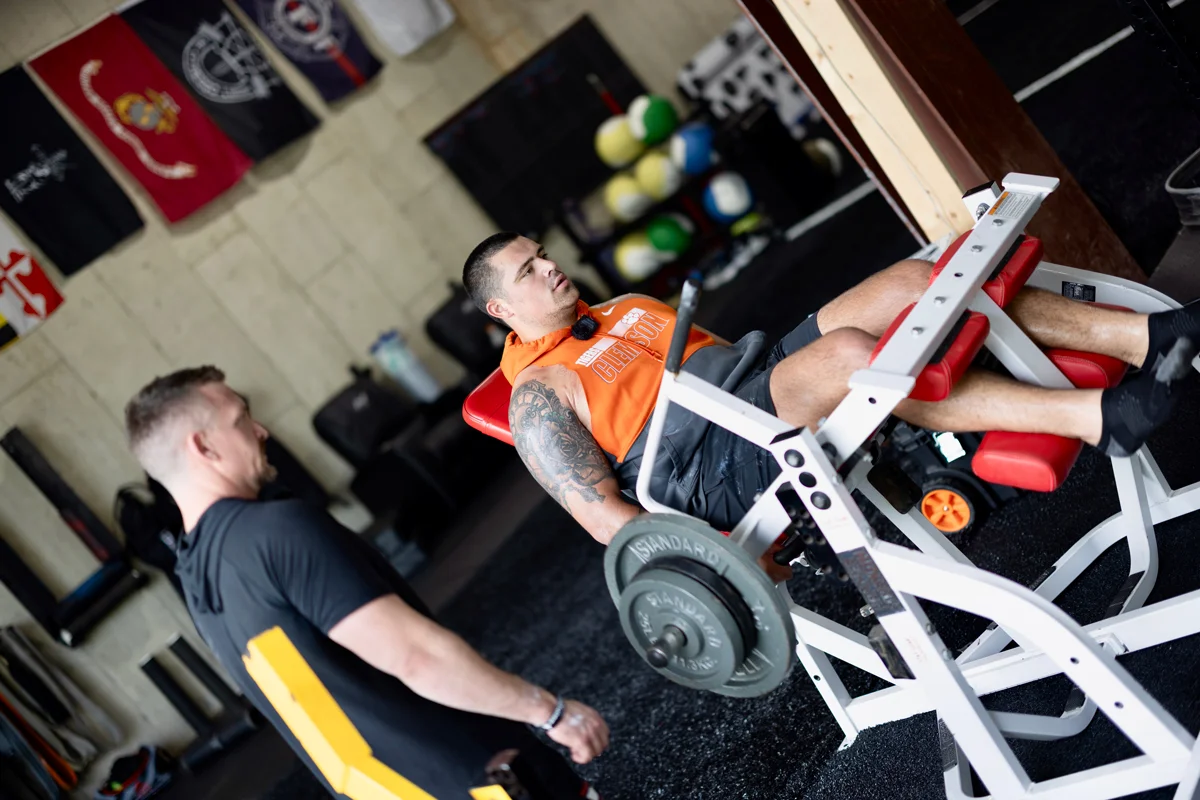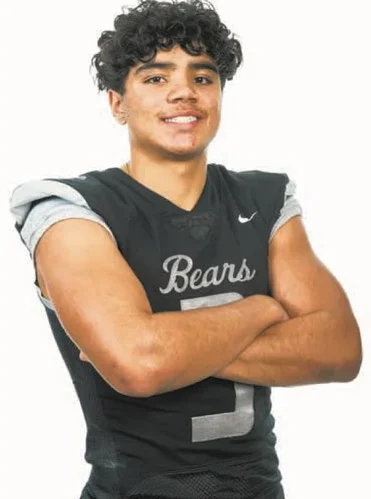Why In-Season Training Is Non-Negotiable for Athletes Who Want to Excel

When the season begins, most athletes—and the adults guiding them—shift focus entirely to
games, practices, and film. It’s a packed schedule, and understandably, the idea of adding more
to the plate feels overwhelming.
We get it. As a parent or coach, you’re likely asking:
“Aren’t they already doing enough?”
“Won’t they get too tired?”
“Isn’t the risk of injury higher if they keep lifting?”
The truth? The real risk comes from doing nothing outside of games and practices.
At PR Strength, we’ve trained hundreds of high-level athletes through both the off-season and
in-season grind. And time and time again, we’ve seen that those who train during the
season—not just before it—don’t just maintain their performance… they elevate it when it
matters most.
In-season training isn’t about pushing harder—it’s about training smarter. It’s about preserving
the progress they’ve worked so hard to build, staying ahead of the competition, and showing up
at their absolute best when the playoffs arrive.
Common Misconceptions: Why Most Athletes Fall Behind Mid-Season
Despite the growing awareness around athletic development, there’s still a major disconnect
when it comes to in-season training. Many parents and coaches unintentionally hold their
athletes back—not because they don’t care, but because they’ve been misinformed.
Here are some of the most common misconceptions we hear:
- “They’ll get too tired.”
This is the #1 concern, and we understand it. But the right in-season program is not about
exhausting the athlete—it’s about supporting them. At PR Strength, we structure training
around recovery, not in spite of it. Sessions are designed to complement the demands of the
sport, not clash with them. - “There’s no time.”
Between school, practices, and games, time is tight. That’s exactly why our system is flexible
by design. With our “In-Season Flex” model, athletes can train when it works for them—even
sliding in on days when practice is canceled or adjusted last minute. We meet them where they
are. - “In-season training isn’t that important.”
Here’s the harsh reality: athletes who stop training once the season begins start losing the
edge they spent months building. Strength drops. Speed drops. Movement quality breaks
down. Worst of all, they enter playoffs—the most important time of year—in the worst physical
condition they’ve been in all season.
The 4 Reasons In-Season Training Is a Game-Changer
If you’re still on the fence, let’s break down exactly why in-season training matters—not just in
theory, but in real-world performance.
- Preserve the Strength They Worked Hard to Build
Off-season training is where athletes make their biggest physical gains—but without
maintenance, those gains fade fast. In as little as 2–3 weeks without strength work, muscle
tissue and force output begin to drop. A well-run in-season program helps protect that
investment, keeping athletes strong, explosive, and resilient throughout the grind of the
season. - Speed Can Detract in Just 7–14 Days Without Exposure
Speed is a perishable skill. Without regular exposure to true max velocity sprinting, athletes
can actually lose their top-end speed in as little as one to two weeks. Game play doesn’t
always provide that stimulus, especially for athletes who aren’t running at full capacity in a
straight line. That’s why we program dedicated max-speed work to keep them sharp. - Enter Playoffs at Your Peak—Not Your Worst
Too many athletes hit their physical peak in week one of the season… and slowly break down
from there. Without in-season training, they lose strength, lose speed, and accumulate fatigue.
The result? They enter championship season feeling sluggish, beat up, and underperforming.
Proper in-season work helps ensure they finish stronger than they started. - Stay Healthier With Mobility and Recovery Work
At PR Strength, every in-season session includes mobility and recovery work—from body tempering to Normatec compression tools and soft tissue prep. These sessions reduce wear and tear, keep joints moving well, and help athletes bounce back quicker between games and practices.
How We Train In-Season at PR Strength
At PR Strength, we know that no two athletes—or schedules—are the same. That’s why we’ve
built an in-season training model that’s as effective as it is flexible.
The “In-Season Flex” Model
Our athletes don’t follow a rigid schedule. Instead, they train on a flex-pass model, giving them
the ability to come in whenever their team schedule allows—whether that’s early morning before
school, or on days when practice gets canceled or rescheduled.
We recommend 1–2 sessions per week during the season. But if an athlete has the ability and
drive to train more, we’re here to support that.
Every Session Covers What Matters Most
Our in-season training focuses on three key areas:
- Max-Speed Stimulus
Every athlete gets at least one sprint session designed to expose them to top-end
speed. This helps maintain—and in some cases, improve—velocity output even while in
season. - High-Intensity, Low-Volume Strength Work
We use lower reps and higher percentages to maintain strength without creating
soreness. The goal is to keep the nervous system firing, muscles responsive, and body
durable—without ever compromising game-day performance. - Mobility & Recovery Focus
From movement prep to soft tissue recovery, every session ends with time dedicated to
maintaining joint health, flexibility, and recovery. We use tools like body tempering,
Normatec boots, and focused mobility drills to help athletes feel better and move
better.
Real Results From PR Strength Athletes
In-season training isn’t theory for us—it’s proven practice. Some of the region’s top athletes
have trusted PR Strength to guide them through their competitive seasons, and the results
speak for themselves.
🏈 Evan Austin – Charlotte WR
Frederick County Player of the Year
Trained 3x per week during his senior season, before school. Maintained peak physical shape from Week 1 to the State Championship.

🏈 Hunter Thompson – Ohio WR
State Championship Game Record Holder & MVP
Also trained 3x per week in-season. Finished stronger than ever—breaking records, winning titles, and earning top recognition when it mattered most.

🏈 Dom Nichols – Michigan Edge
Top Recruit in Maryland, Now Competing at Michigan
Stayed on a consistent 3x/week in-season schedule. Increased speed and strength by 5%, stayed injury-free, and entered early college enrollment in January fully prepared to compete at the next level.

These three didn’t just survive the season—they thrived through it.
They helped lead their team to a 14-0 record and a state championship, without missing a
single game. And thanks to their in-season consistency, they walked into college
game-ready—not rebuilding.
Don’t Let the Season Undo the Work
The off-season is where you build.
The in-season is where you protect and elevate that progress.
If you’re a parent, coach, or athlete who’s serious about long-term development, now is the time
to take action. Don’t let fatigue, fear, or scheduling myths hold your athlete back from reaching
their full potential when it matters most.
At PR Strength, we’ve built a system that works—on your schedule, with your goals in mind.
Whether your athlete is chasing a championship, preparing for college ball, or simply looking to
stay healthy and sharp, we’re here to guide that journey.
✅ Want your athlete to stay strong, fast, and healthy all season long? Let’s make sure they don’t just start strong—they finish stronger.
Email CoachReeves@PRStrengthtraining.com to learn more.
Ready to Get Stronger, Faster, Better?
Connect with PR Strength!
Sign up to get expert tips, training insights, and exclusive offers from PR Strength!
